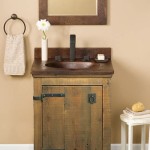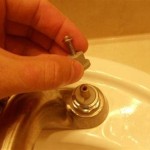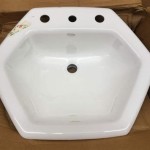```html
How to Remodel Bathroom Sink Cabinets
Remodeling bathroom sink cabinets is a common home improvement project that can significantly enhance the aesthetic appeal and functionality of a bathroom. Whether undertaking a complete bathroom renovation or simply upgrading existing cabinetry, a clear understanding of the process is essential. This article provides a comprehensive guide to remodeling bathroom sink cabinets, covering various aspects from planning and preparation to installation and finishing.
The scope of a bathroom sink cabinet remodel can vary greatly depending on the desired outcome and existing conditions. It may involve simply refinishing existing cabinets, replacing hardware, or completely removing and replacing the entire cabinet structure. Assessing the current state of the cabinets is the first step in determining the most appropriate course of action.
Before embarking on the remodel, it is crucial to establish a clear budget and timeline. This will help in managing expenses and ensuring the project stays on schedule. Consider potential unforeseen costs, such as plumbing repairs or unexpected structural issues, when formulating the budget.
Planning and Preparation
Effective planning is the cornerstone of a successful bathroom sink cabinet remodel. This phase involves several key considerations, including design choices, material selection, and necessary permits. Failing to adequately plan can lead to costly errors and delays.
Begin by assessing the existing bathroom layout and determining how the new sink cabinets will integrate into the overall design. Consider factors such as the placement of the sink, toilet, and shower, as well as the available floor space. Measure the dimensions of the existing cabinets and the surrounding area to ensure the new cabinets will fit properly.
Next, explore different design options for the new sink cabinets. Consider the style, color, and materials that will complement the existing bathroom décor. Options range from traditional wood cabinets to modern floating vanities. Research different styles and finishes to find the ideal match for the desired aesthetic. Online resources, home improvement magazines, and design professionals can provide valuable inspiration and guidance.
Material selection is another critical aspect of the planning phase. Common materials for bathroom sink cabinets include wood, laminate, and metal. Wood cabinets offer a classic and durable option, but they require proper sealing to prevent water damage. Laminate cabinets are a more affordable and low-maintenance alternative, but they may not be as durable as wood. Metal cabinets provide a modern and sleek look, but they can be susceptible to rust and corrosion.
Prior to beginning any demolition or installation work, confirm whether any permits are required. Check with the local building department to determine the specific regulations in the area. Obtaining the necessary permits can prevent potential fines and delays.
Gather all necessary tools and materials before starting the remodel. This includes items such as a screwdriver, wrench, level, measuring tape, safety glasses, and dust mask. Having all the tools and materials readily available will streamline the process and minimize disruptions.
Protect the surrounding areas from dust and debris by covering floors and fixtures with drop cloths or plastic sheeting. This will help to keep the bathroom clean and prevent damage to existing surfaces.
Demolition and Removal
The demolition and removal phase involves carefully dismantling the existing sink cabinets and preparing the area for the new installation. This step requires caution to avoid damaging plumbing fixtures or electrical wiring.
Begin by shutting off the water supply to the sink. Locate the shut-off valves under the sink and turn them clockwise until they are completely closed. If the shut-off valves are not functioning properly, it may be necessary to shut off the main water supply to the house.
Disconnect the plumbing connections to the sink. This includes the water supply lines and the drainpipe. Use a wrench to loosen the connections and carefully detach the lines. Place a bucket under the drainpipe to catch any remaining water.
Remove the sink from the cabinet. Depending on the type of sink, it may be attached to the cabinet with clips, screws, or adhesive. Carefully detach the sink from the cabinet and set it aside.
Detach the old cabinets from the wall. Use a screwdriver or drill to remove any screws or nails that are holding the cabinets in place. Gently pull the cabinets away from the wall, being careful not to damage the drywall or any underlying structures.
Inspect the exposed wall and floor for any damage or imperfections. Repair any holes or cracks in the drywall and level the floor if necessary. This will ensure a smooth and even surface for the new cabinets.
Clean the area thoroughly to remove any dust, debris, or old adhesive. This will help the new cabinets adhere properly to the wall and floor.
Installation of New Cabinets
The installation phase involves carefully installing the new sink cabinets according to the manufacturer's instructions. Proper alignment and secure attachment are essential for a stable and functional installation.
Begin by positioning the new cabinets in the desired location. Use a level to ensure the cabinets are perfectly level both horizontally and vertically. Adjust the leveling feet on the bottom of the cabinets as needed.
Secure the cabinets to the wall using screws or bolts. Locate the wall studs and drill pilot holes through the back of the cabinets into the studs. Use screws or bolts that are long enough to penetrate the studs securely. This will ensure the cabinets are firmly attached to the wall.
Install the countertop and sink. Follow the manufacturer's instructions for installing the countertop and sink. Ensure the countertop is properly sealed to prevent water damage.
Reconnect the plumbing connections. Reattach the water supply lines and the drainpipe to the sink. Tighten the connections securely to prevent leaks. Turn on the water supply and check for leaks.
Install the cabinet hardware, such as knobs and pulls. This will add the finishing touches to the new cabinets and enhance their aesthetic appeal.
Caulk any gaps or seams around the cabinets and countertop. This will prevent water from seeping behind the cabinets and causing damage.
Clean the area thoroughly to remove any dust or debris. This will leave the bathroom looking clean and refreshed.
After installation, it is prudent to inspect the completed work. Verify that all connections are secure, the cabinets are level and stable, and all components function as intended. Address any discrepancies or issues promptly.
Regular maintenance is essential to prolong the life of newly installed bathroom sink cabinets. Clean the cabinets regularly with a mild soap and water solution. Avoid using abrasive cleaners or harsh chemicals, as these can damage the finish. Inspect the plumbing connections periodically for leaks and address them promptly.
Consider adding organizational accessories to the new sink cabinets to maximize storage space and improve functionality. These may include drawer dividers, pull-out shelves, and door-mounted organizers. These accessories can help to keep the bathroom clutter-free and organized.
The level of difficulty associated with remodeling bathroom sink cabinets can vary based on several factors, including the scope of the project, the existing conditions of the bathroom, and the individual's skill level. Some individuals may prefer to hire a professional contractor to handle the project, while others may opt to tackle it themselves.
```
Updating A Bathroom Vanity

Diy Bathroom Vanity

A Step By Guide To Designing Your Bathroom Vanity

Diy Bathroom Vanity

How To Use Cabinets Organize Your Bathroom

30 Designer Bathroom Cabinet Ideas For A Spa Like Space

The Ingredients To A Contemporary Bathroom Vanity Style Kauffman Blog

Diy Master Bath Remodel Part 2 Modern Double Bathroom Vanity Pneumatic Addict

Diy Double Bathroom Vanity Addicted 2

6 Modern Bathroom Vanity Design Ideas Lily Ann Cabinets
Related Posts







